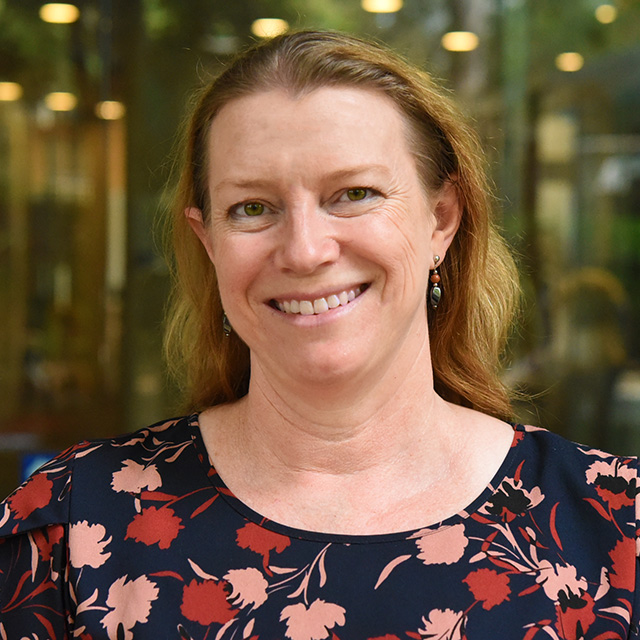Martina Jones: Behind the breakthroughs
For more than 3 decades, Martina has been a fixture at The University of Queensland – a rare and steady force in a sector defined by rapid change. Today, she serves as Operations Manager of the National Biologics Facility (NBF) at the Australian Institute for Bioengineering and Nanotechnology (AIBN), where she leads a team helping to transform early-stage discoveries into clinical trial-ready biologic therapies.
After earning her Bachelor of Applied Science in Biotechnology, Martina worked as a research assistant, completed a PhD under Ross Barnard while raising 2 children, and then joined NBF when it was just beginning. She’s been at the Facility since 2008 and in her current leadership role since 2016.
Making research real
Funded through the Australian government’s NCRIS infrastructure initiative, NBF is part of Therapeutic Innovation Australia. It operates as both a research and service facility, providing expertise and production capabilities to scale up recombinant protein therapies for pre-clinical and clinical trials.
Researchers from across Australia – and even internationally – come to NBF with promising lab-scale therapeutics. Martina and her team help them bridge the often-daunting gap to clinical development. “Most researchers have never had to think about what it takes to get to a clinical trial,” she explains.
“We help them navigate everything from scale-up manufacturing to regulatory strategy.”
That guidance has translated into impact: since 2020, the Facility has supported 5 projects into Phase 1 clinical trials – an impressive feat given the immense complexity and cost. NBF works on 30 to 40 projects each year, from early stage discovery to Phase 1 manufacturing. “It might be as simple as providing a few milligrams of protein,” Martina says. “But for a researcher, that can make all the difference.”
A career in collaboration
One of the joys of the job, Martina says, is variety. Unlike researchers who may spend years focused on a single disease, she oversees a broad portfolio of projects and collaborates with scientists around the country and the world.
A standout example is the Facility’s ongoing work on a Hendra virus antibody, manufactured for Queensland Health and administered under compassionate use protocols to those potentially exposed. Other projects span cancer, inflammatory diseases, and pandemic preparedness by developing platform technologies for vaccine development.
During the COVID-19 crisis, Martina and her team worked closely with Keith Chappell’s lab at UQ to support development of a vaccine candidate. “It was surreal. We were coming in every day while the rest of the city stayed home. But the urgency gave us energy.”
Longevity and legacy
Martina believes the Facility’s impact is amplified by its continuity. “Some of our collaborations last 5 or 10 years,” she says. “That kind of long-term relationship fosters deep knowledge transfer and better problem-solving.”
And with a team of 15 expert scientists specialising in various aspects of biologics development, NBF’s greatest assets go well beyond equipment. “We learn from every protein we work with,” Martina says. “Solutions to one problem often apply to another.”
Administrative barriers, like negotiating detailed service agreements across institutions, are some of the biggest challenges. “Sometimes the paperwork takes months. Meanwhile, the researchers just want to get started,” she says. It’s her job to keep momentum going.
Future of biotech, and of NBF
Martina sees great promise in AI for therapeutic discovery, particularly in antibody design, but says protein production will remain reliant on biological systems for the foreseeable future. “AI can help predict protein structure or optimise conditions, but it can’t replace living cells,” she explains.
She predicts a future of increasingly personalised medicine – where genomic profiling determines the most effective treatment for each individual.
“We’ll see more targeted therapies, and biotechnology will be central to making that happen.”
Monoclonal antibodies, once a novelty, are now the highest-revenue therapeutic class, and NBF has played a behind-the-scenes role in that transformation.
Reflections from a lifelong UQ scientist
Despite 3 decades at UQ, Martina still loves the environment. “It’s beautiful, it’s collaborative, and it keeps me young,” she laughs. She values the flexible working culture and the vibrant student presence on campus.
She also believes strongly in the importance of hands-on experience. NBF routinely hosts honours, masters and PhD students integrating them into both the facility and broader research projects. “That exposure is critical,” she says. “It’s where the next generation learns what science looks like in practice.”
Her advice to students entering the field? “Biotech is a great industry with so many paths – research, industry, or both. Just do what you enjoy. Careers evolve. Most people jump around and change.”
Martina never set out to have a 30-year UQ career. But through dedication, curiosity, and quiet leadership, she’s built something extraordinary – helping others make the leap from discovery to therapeutic reality, one molecule at a time.

Dr Martina Jones
PhD, 2008
Bachelor of Applied Science (Honours), 1998
aibn.uq.edu.au
linkedin.com/in/martina-jones-0531b458

 Read more inspiring stories from UQ biotechnology alumni
Read more inspiring stories from UQ biotechnology alumni